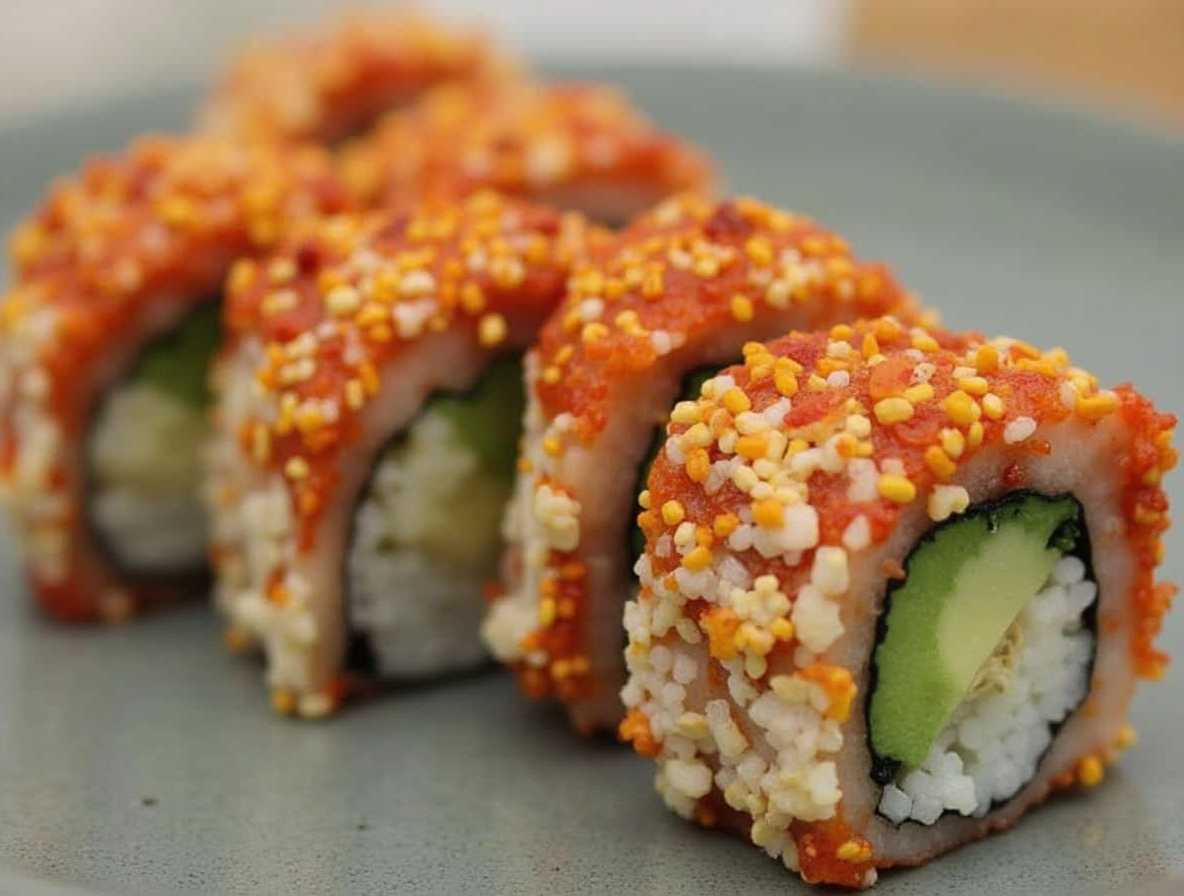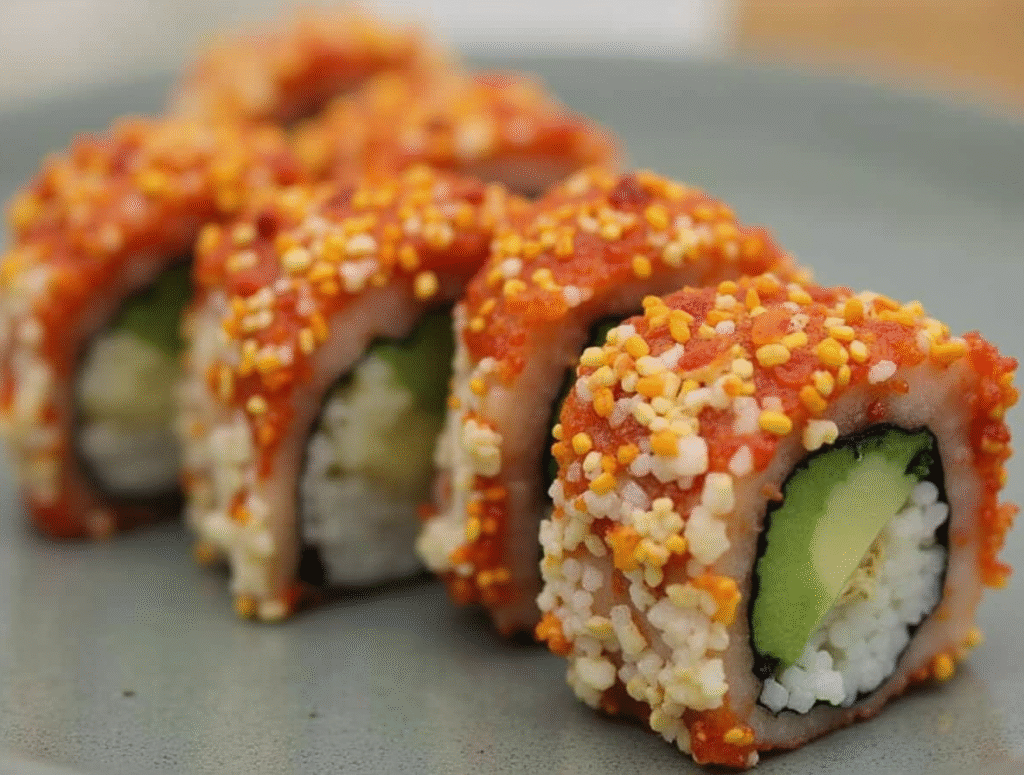How to Make the Perfect Volcano Roll: Chef’s Secret Recipe Revealed
The volcano roll stands as one of the most indulgent and beloved items on many Japanese restaurant menus across America. Although this mouthwatering sushi creation might seem intimidating to prepare at home, I’ve discovered it’s surprisingly accessible with the right techniques. In fact, you can easily replicate this restaurant favorite using just a toaster oven and a few key ingredients.
When exploring volcano roll ingredients, you’ll find a delicious combination of seafood options like shrimp, scallops, or salmon topped with a signature spicy mayo sauce. The volcano roll recipe is completely customizable based on your preferences, whether you prefer a milder flavor or something with serious heat. What is in a volcano roll often varies, but the essentials typically include perfectly seasoned sushi rice, fresh seafood, and that irresistible baked topping that gives the roll its “erupting” appearance. Even a deep fried volcano roll sushi recipe can be simplified for home preparation. In this guide, I’ll share everything you need to know to create this impressive 8-10 piece roll that’s perfect for sharing at your next gathering.
Volcano Roll Ingredients and Tools
Creating a restaurant-quality volcano roll starts with gathering the right ingredients and tools. First of all, the components can be broken down into categories that work together to create this impressive sushi masterpiece.
Sushi rice and seasoning
The foundation of any great volcano roll is properly prepared sushi rice. Japanese short-grain white rice is essential due to its higher moisture content and natural stickiness that holds your roll together. For authentic flavor, add a piece of kombu (dried kelp) when cooking your rice to infuse it with subtle umami. The seasoning mixture combines rice vinegar, sugar, and salt, which should be added while the rice is still hot for proper absorption. Remember to use a cutting motion rather than stirring when mixing the seasoning into the rice to prevent it from becoming mushy.
Seafood options: shrimp, scallop, or salmon
The volcano topping typically features one or a combination of seafood options. Raw jumbo shrimp (cleaned and deveined), bay scallops, or fresh salmon pieces work beautifully. These are chopped into small pieces and mixed with the signature sauce before being baked to create the “erupting” effect. Additionally, many volcano rolls include imitation crab sticks in the filling, which provide a contrasting texture to the baked topping.
Vegetables and fillings
Fresh vegetables add crunch and balance to your volcano roll. Traditional options include thinly sliced cucumber (with seeds removed for better texture), ripe avocado slices, and green onion stalks. Furthermore, some recipes include cream cheese for added richness. Toasted sesame seeds make an excellent garnish that adds both flavor and visual appeal to the finished roll.
Spicy mayo and other sauces
The signature volcano sauce combines:
- Japanese Kewpie mayonnaise (⅔ cup)
- Sriracha hot sauce (2 tablespoons)
- Optional: fresh lime juice for brightness
This mixture creates the perfect balance of creamy, spicy, and tangy flavors. The spiciness can be adjusted according to your preference by adding more or less Sriracha. Some recipes also include a wasabi mayo variation for additional complexity.
Essential tools for rolling sushi
To create perfect volcano rolls, you’ll need specialized tools. A bamboo rolling mat (makisu) is indispensable for shaping uniform, tightly packed rolls. Equally important is a flat-headed bamboo paddle (shamoji) for handling the sticky rice without damaging the grains. A sharp knife is crucial—professionals recommend an 8″ Gyuto (Japanese chef’s knife) for clean cuts through delicate sushi rolls. Plastic wrap placed over your bamboo mat prevents rice from sticking during rolling. To complete your setup, prepare a small bowl of water to keep your hands moist while handling the sticky rice.
Preparing the Base: Rice and Fillings
Mastering the base components of a volcano roll requires precision and care. Initially, focus on preparing perfect sushi rice, which serves as the foundation for this impressive dish.
How to cook and season sushi rice
For authentic volcano roll rice, use Japanese short-grain white rice with a precise 1:1 rice-to-water ratio. Begin by thoroughly rinsing the rice until the water runs clear, removing excess starch. Subsequently, soak the cleaned rice for 20-30 minutes to allow water penetration into the grains. For enhanced flavor, add a piece of kombu (dried kelp) before cooking.
Once cooked, transfer the hot rice to a wide vessel and immediately add your sushi vinegar mixture (typically ½ cup rice vinegar, ¼ cup sugar, and 1 teaspoon salt). Instead of stirring, use a cutting motion with your rice paddle at a 45-degree angle to preserve the rice’s integrity. Simultaneously, fan the rice to cool it quickly, preventing mushiness while creating a glossy finish.
Making the crab salad or spicy tuna
For the crab salad filling, finely chop imitation crabmeat and combine with Kewpie Japanese mayonnaise. Alternatively, prepare spicy tuna by mincing sashimi-grade tuna and mixing with 4 teaspoons of Sriracha, ½ teaspoon sesame oil, and minced green onion.
For the volcano roll’s signature topping, mix Japanese mayonnaise with Sriracha, soy sauce, and sesame oil. Then fold in finely chopped salmon or shredded crab until well coated.
Cutting and prepping vegetables
English or Japanese cucumbers work best for volcano rolls since they have thinner skin and fewer seeds. Measure and cut cucumber to match the length of your nori sheet, then slice into 3/8-inch strips. Gently remove seeds with a spoon to prevent excess moisture in your roll.
For avocados, cut in half lengthwise around the seed, then twist to separate halves. Slice each quarter lengthwise, remove the skin, and cut into thin strips. Sprinkle with lime juice to prevent browning.
Throughout preparation, keep a bowl of water nearby to moisten your hands when handling sticky rice. This prevents the rice from adhering to your fingers, making the entire assembly process significantly more manageable.
Rolling and Assembling the Sushi
Assembling your volcano roll transforms your prepared ingredients into a visually striking dish. The rolling process requires patience, but becomes easier with practice.
Laying out the nori and rice
On your bamboo mat covered with plastic wrap, place a sheet of nori with the rough side facing up. The lines should run parallel to the bamboo strips of your mat. For a standard volcano roll, spread approximately 1 cup of prepared sushi rice evenly across the nori, leaving about a half-inch space at the far edge to help seal the roll later. For an inside-out variation, cover the entire nori with rice, then carefully flip it over so the rice faces down onto the plastic wrap.
Adding fillings and rolling tightly
Position your fillings slightly off-center near the edge closest to you. For volcano rolls, place your crab mixture, cucumber strips, and avocado slices in neat horizontal lines. To begin rolling, lift the edge of the mat closest to you and bring the bottom edge of the nori over the fillings. As you roll, gently squeeze to compress the ingredients without crushing them. Continue rolling forward while simultaneously pulling the mat back to prevent it from getting caught inside.
Tips for using a bamboo mat and plastic wrap
Covering your bamboo mat with plastic wrap is essential – it prevents rice from sticking and makes cleanup significantly easier. For inside-out rolls, the plastic serves as a barrier between the sticky rice and the mat. Once your roll is formed, use the mat to shape it into a uniform cylinder by wrapping it around the roll and applying gentle pressure. For the perfect volcano roll presentation, wet your knife between each slice to prevent tearing the nori. Cut the roll into 6-8 equal pieces in clean, decisive motions rather than sawing back and forth.
Moreover, if you don’t have a bamboo mat, a clean kitchen towel wrapped in plastic can serve as an adequate substitute for rolling your volcano roll.
Creating the Signature Volcano Topping
The signature topping transforms an ordinary sushi roll into a volcanic masterpiece. This flavorful crown gives the volcano roll its name and provides that wow factor when served.
Mixing seafood with spicy mayo
The heart of the volcano topping begins with your choice of seafood. You can use raw shrimp, scallops, salmon, or a combination for varied texture and flavor. For the classic spicy mayo sauce, whisk together ⅔ cup of Kewpie Japanese mayonnaise with 2 tablespoons of Sriracha. For extra depth, some recipes include 1 teaspoon of soy sauce and 2 teaspoons of sesame oil. Afterwards, toss your finely chopped seafood in this mixture until well coated. Imitation crab is another popular option, often combined with cream cheese for added richness.
Baking or broiling the topping
Once your seafood mixture is prepared, it’s time to cook. Preheat your oven to 400°F and bake the seafood topping for 12-15 minutes or until the shrimp is fully cooked. For that golden restaurant-quality finish, switch your oven to broil for an additional 1-2 minutes. This extra step creates that slightly charred appearance that mimics flowing lava. Alternatively, you can broil the topping separately for about 10 minutes before adding it to your roll, followed by a quick 2-minute broil of the assembled roll.
Layering the topping on the roll
Primarily, there are two approaches to applying the topping. You can either spoon the mixture onto individual cut pieces of sushi or spread it across the entire uncut roll first, then slice through plastic wrap for cleaner cuts. Indeed, the latter method tends to be easier and faster, producing more visually appealing results. Once layered, give the roll a gentle squeeze with your bamboo mat to ensure the topping adheres properly.
Optional garnishes: masago, sesame seeds, sauces
To complete your volcano roll, add garnishes that enhance both appearance and flavor. Masago (capelin roe) or tobiko (flying fish roe) create the perfect lava-like effect with their bright orange-red color. Notably, black sesame seeds provide visual contrast and a nutty accent. Drizzle additional spicy mayo and unagi (eel) sauce in decorative patterns across the top. Finally, chopped green onions add a fresh pop of color and flavor.
Conclusion
After following this guide, you’ll find that creating restaurant-quality volcano rolls at home becomes surprisingly straightforward. Although the process might seem complex initially, breaking it down into manageable steps makes this impressive dish accessible to any home chef.
Therefore, don’t hesitate to experiment with your volcano roll creations. You might prefer spicier toppings or different seafood combinations – the beauty of making sushi at home lies in customization. Additionally, preparing volcano rolls for friends and family will certainly impress them while allowing you to perfect your technique with each attempt.
Most importantly, remember that sushi-making combines both art and science. The precision of rice preparation matters equally as much as the creative presentation of your volcanic topping. Undoubtedly, your skills will improve with practice, and soon you’ll develop your own signature variations.
Lastly, while traditional restaurants might charge premium prices for this specialty roll, your homemade version delivers the same delicious experience at a fraction of the cost. Whether you serve these rolls for a special occasion or simply to satisfy your sushi cravings, your homemade volcano rolls will rival any restaurant offering once you master these techniques.
So gather your ingredients, prepare your bamboo mat, and start creating your own eruption of flavors. The satisfaction of crafting something both beautiful and delicious makes the entire process worthwhile.
FAQs
Q1. What are the key ingredients for making a volcano roll? The key ingredients for a volcano roll include sushi rice, nori (seaweed sheets), seafood like shrimp, scallops, or salmon, vegetables such as cucumber and avocado, and a spicy mayo sauce. The signature topping is made by mixing chopped seafood with a spicy mayo mixture.
Q2. How do I prepare the sushi rice for a volcano roll? To prepare sushi rice, rinse Japanese short-grain rice until the water runs clear, then cook it with a 1:1 rice-to-water ratio. Once cooked, season the hot rice with a mixture of rice vinegar, sugar, and salt. Use a cutting motion to mix the seasoning, and fan the rice to cool it quickly for the perfect texture.
Q3. What’s the best way to roll a volcano roll? Place a sheet of nori on a bamboo mat covered with plastic wrap. Spread sushi rice evenly, leaving a small strip at the far edge. Add your fillings near the edge closest to you. Lift the mat and roll tightly, squeezing gently to compress the ingredients. Use the mat to shape the roll into a uniform cylinder.
Q4. How do I create the signature volcano topping? Mix chopped seafood with a sauce made from Japanese mayonnaise, Sriracha, and optionally soy sauce and sesame oil. Spread this mixture on top of the roll, then bake in a preheated oven at 400°F for 12-15 minutes. For a golden finish, broil for an additional 1-2 minutes.
Q5. Can I customize my volcano roll? Absolutely! You can customize your volcano roll by choosing different seafood options, adjusting the spiciness of the mayo sauce, or adding unique vegetables and garnishes. Some variations include using cream cheese or making an inside-out roll. The beauty of homemade sushi is the ability to tailor it to your preferences.


